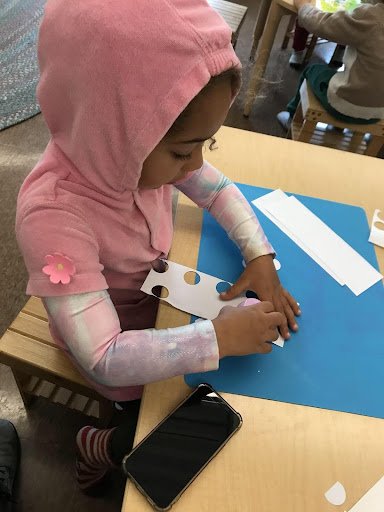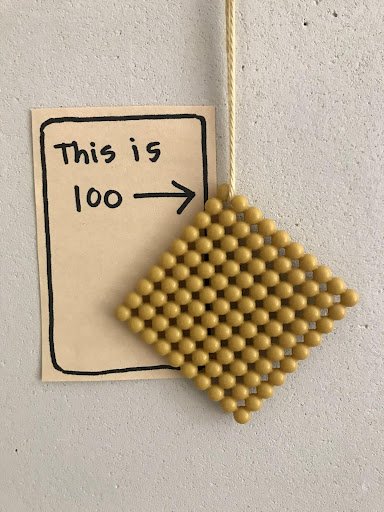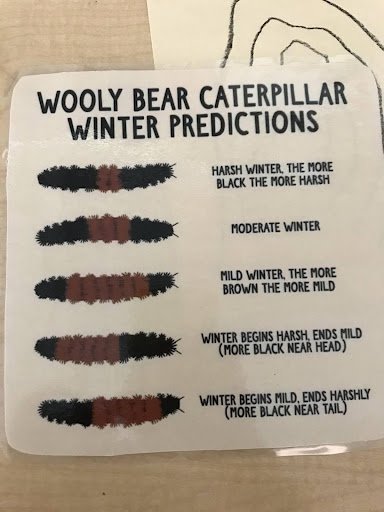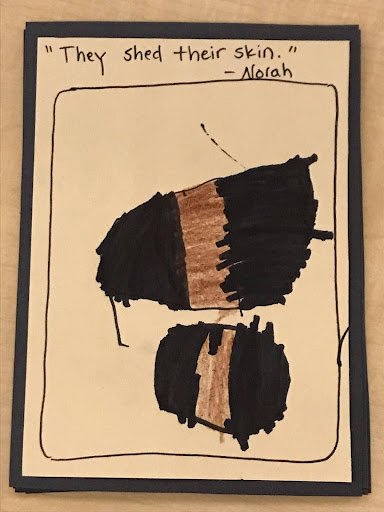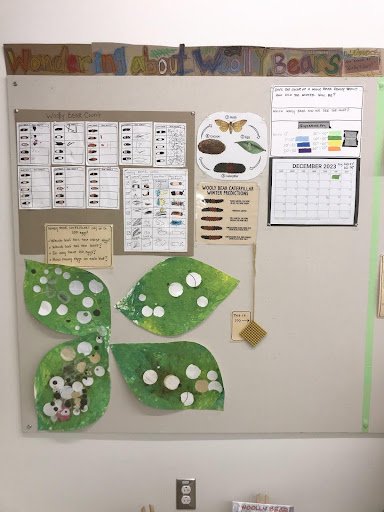Wondering About Woolly Bears in the Preschool (2-4 yr. olds)
*sign colored with help from Enzo from Puzzle Primes, the spelling of woolly/wooly is a debated issue on the internet, so forgive the inconsistent spelling here too please.
This fall the campus was teeming with Wooly Bear Caterpillars! Maybe they are having a boom year, or maybe we just haven’t noticed them until now. Early in the fall, preschoolers found hundreds of white eggs on the playground and in our woods spot. At first we thought they were slug eggs (we have seen a lot of slugs too). However, after doing a little research, we found out that they were actually Wooly bear eggs, and that they can lay as many as 100 eggs at a time.
In order to illustrate just how many 100 is, we set to work using our hole punchers to try and punch out 100 circles. The circles would represent the eggs on collaborative paintings that we made of leaves, one of the many places that the eggs are found. We also explored some Montessori math materials that are typically used to teach decimals.
In our research we also found out that these amazing creatures actually hibernate outside all winter before emerging as Isabella Tiger Moths. Super Primes are fascinated by the folklore or myth that the size of the brown strip on the caterpillar can predict the severity of the winter.
Here are some things that Super Primes know, think or wonder about Wooly Bears
Violet: “They hibernate in winter.”
Poe: “They inch or crawl.”
Izzy: “They have a band that tells you about winter and they crawl under leaves.”
Norah: “They turn into moths in the spring.”
Korra: “I found some outside.”
Violet: “I think they eat tiny rocks and clover.”
Izzy: “And plants in the garden.”
Whitney: “And grass.”
Poe: “I think they eat leaves.”
Korra: “I think grass.”
Poe: “Now they hibernate.”
Norah: “And they shed their skin.”
Violet: “They shed and hibernate.”
Izzy: “They hide.”
Violet: “That’s because they camouflage.”
Korra: “I wonder where they will spend their winter and what their cocoons look like.
Super Primes learned how to collect data on the Wooly Bears. We created a table with the different color patterns found on wooly bears, and made a mark each time we found one. Recently, when asked what kind of Wooly Bears they saw the most of, the Super Primes responded
Violet: “The one with a little black and a lot of brown.”
Norah: “A lot of black on the front, and a little in the back.”
Whitney: “I saw them with a lot of black on the front and on the back.”
Lili: “I saw the other kind, a lot of any other kind.”
We then expanded on the information we were collecting, adding location, and what the Wooly Bear was doing when we found them. Wooly Bears appeared to be more active in the sunny weather and we wanted to test that theory. One day, on a sunny spot on the hill near our woods spot, we found 18 Wooly Bears all within feet of each other. Should we name that spot Wooly Bear Hill?
Most of the Wooly Bears that we have found have had a large stripe of brown, centered more toward the back of the body. The folklore tells us that this means that we will have a winter that starts out harsh, and becomes mild earlier than usual! Most of the Super Primes are hoping for a “harsh winter” and are excited to see if the Wooly Bears are wrong. After a debate about when winter starts, either on the solstice or 12/1, we decided to start keeping track of the daily high temperatures on the first of December. We will color code each day, depending on the temperature. In the spring we will decide if the winter followed the prediction of the Wooly Bears or not. Nine out of ten Super Primes think that the Wooly Bears will be right!
As we learn more about Wooly Bears, and track the temperatures, we will add to our documentation in the studio. Please come by and see this great work in person!




